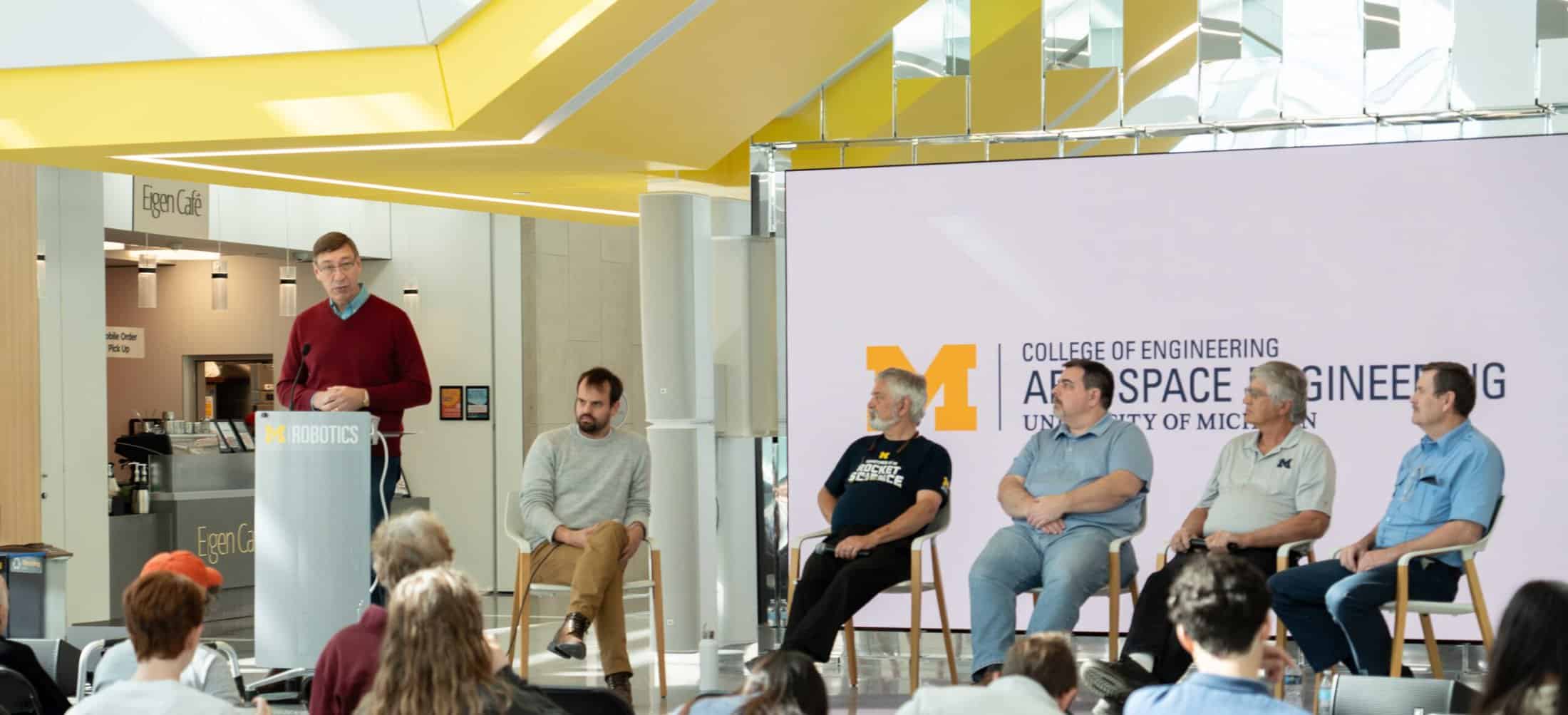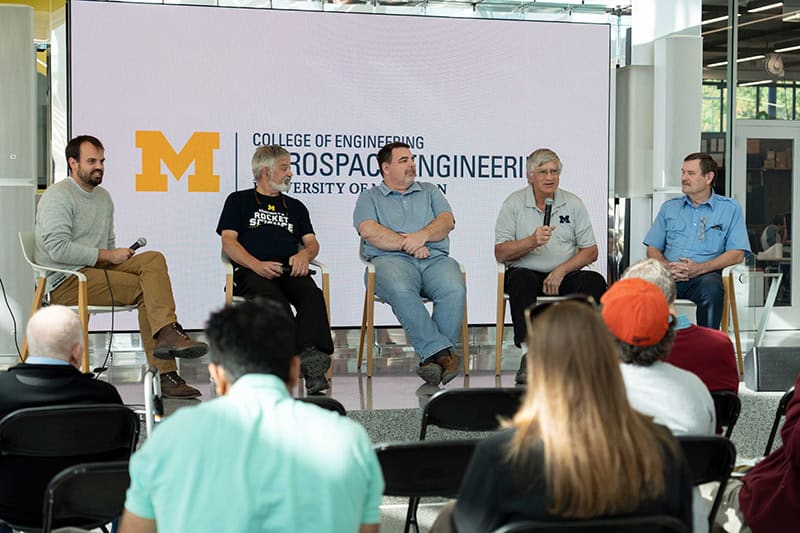
History of Michigan Aerospace from a Tech Team Perspective
The second of a three-part special 110th anniversary celebration series reflecting on the department’s past, present and future

The second of a three-part special 110th anniversary celebration series reflecting on the department’s past, present and future
Earlier this month the Michigan Aerospace Technician Team joined us for our second event of the 110th anniversary celebration series taking place this fall semester, reflecting on the past, present and future of the University of Michigan Department of Aerospace Engineering. The team spent the afternoon sharing stories and insights into the history behind the physical aspects of the François-Xavier Bagnoud (FXB) Building and the previous Aerospace Engineering facilities.
The panel discussion featured technicians Doug Barr, Christopher Chartier, David McLean, Thomas Griffin and Terry Larrow. Together, this team of technicians are in charge of maintaining and caring for a range of facilities, including the FXB Building, the department’s various wind tunnels, the Peach Mountain Observatory and the Plasmadynamics & Electric Propulsion Laboratory (PEPL) on Green Road.

During the event they shared a variety of stories focused on the current and former buildings and facilities that have housed the Aerospace Department throughout the years. The panel also highlighted specific important items that have helped inspire students throughout their journey in the program and provided insights about the artifacts that are featured around the FXB Atrium and in the halls.
One of the main highlights of the panel was Griffin and Larrow explaining what it was like moving from the old Aerospace Engineering Building into what is now the FXB Building. Thanks to the generosity of the François-Xavier Bagnoud Foundation, the FXB Building and the adjacent Wave Field stands today in honor of beloved U-M Aerospace Engineering Alumni, François-Xavier Bagnoud. The FXB Building was completed in 1993 with the lab section of the complex being built first before the old North Campus Research Activities Building was torn down and replaced with the section of FXB that now houses the office space and class rooms.
Larrow specifically explained that the old Research Activities Building sits under what is now the FXB Atrium. The old Aerospace Engineering building in fact still exists, and is now used to house the department’s wind tunnels, Gorguze Family Laboratory and the Wilson Student Team Project Center. “It was a very exciting time for us. When we first moved into FXB we had all the room anyone could want and all the lab space we could possibly want,” explained Griffin during the event.
The tech team went on to discuss many of the artifacts within the FXB Atrium, including the legendary McDivitt moon rock. Griffin explained how the moon rock had been awarded to U-M Aerospace alumni James McDivitt after his flight to the moon and then had been gifted to the department to display. He highlighted the work the technician team went through to ensure the safety and security of the moon rock, ensuring its longevity within the building.
The atrium also houses memorabilia of another outstanding U-M Aerospace alumni, Clarence “Kelly” Johnson, featuring photos and awards from his career. “I think the favorite piece of just about anything in our building is his sketchbook. He had drawn pictures of airplanes and all kinds of neat stuff,” explained Chartier. “He had cut articles out of magazines and pasted them in the sketchbook and there was even a letter grade from one of his elementary school teachers, obviously he got an A on it, but that sketchbook is from when he was 12 years old. To be able to look that far back into someone’s life and see the exact trajectory his life had taken is pretty cool and we got to be a part of that.”
Additionally, the panelists touched on one of the most notable features in the atrium of the FXB Building, the Nomad aircraft. The Nomad, an aluminum, semi-monocoque recreational craft, was a pusher propeller airplane and was the first of two aircrafts built by U-M Aerospace Professor Edgar “Ed” Lesher. The aircraft featured a 100 horsepower 0-200A Continental engine which sat at the center of the plane behind the cockpit and in October 1961, after 5,000 hours of construction, the Nomad flew with Lesher as the pilot.
From there he went on to build his second plane, the Teal, which was designed to break world records. Throughout his journey, Lesher had set his seven world aviation records, placing him as a key figure in aviation history.
“He was going to build another plane and part of it is still in the 2×2 wind tunnel. He built the original wing that was going to be used for that plane and none of us could figure out how he planned on getting that plane out of the building, because the wing is just huge, about 40 feet, and if he built the rest of the plane to go with it, it would have been a difficult task to get it out,” stated Griffin.
Chartier also showcased the department’s wind tunnels, explaining the process of keeping them in good working condition for the various research projects that utilize them. Not only does the Aerospace Engineering Department make use of the 5×7 wind tunnel, which features engines that were built by General Electric and donated by the city of Detroit, but many other engineering teams use it as well. The tunnel has been used to test various automobiles and winglets throughout the years, as well as been used to test the Solar Car Team’s competition winning cars.
As the Department of Aerospace Engineering continues to reflect on the historical journey of the facilities and those that have walked the halls, the tech team was proud to highlight many of the key aspects and stories surrounding its history. While our faculty, students and alumni continue to set their mark on the industry, the Michigan Aerospace tech team continues to provide endless support as the department looks forward to another 110 years of advancing aerospace engineering.